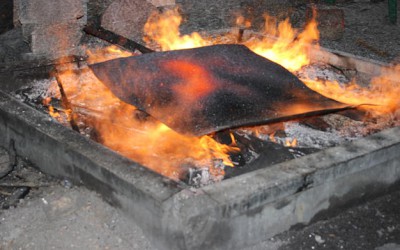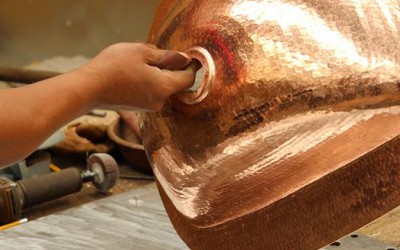What is Copper Patina?

Copper patina is a thin layer that forms on the surface of copper as a result of natural oxidation or chemically induced. Natural oxidation of copper occurs as a result of exposure to atmospheric elements such as acidic rain, carbon dioxide, oxygen and other sulfur bearing compounds. The process by which a patina is formed is known as patination. Formation of copper patina makes a body to lose its original color and texture and forms a bluish or a greenish surface. The nature of the patina formed depends on the environmental conditions surrounding the copper body.
In clean environments such as rural areas, natural patina is formed by a slow chemical reaction that leads to the formation of copper carbonate. In urban areas, where the environment is endowed with sulfurous acid rain, the copper patina formed is mainly composed of sulphide and sulphate compounds. The color of the patina formed can be either green or blue depending on the composition of copper and the chemicals that lead to patination.
Different Types of Patinas
There are two main types of patinas, natural patinas and applied patinas.
Natural Copper Patina
Also known as unintentional patinas are formed as a result of exposure of copper to oxidizing environment. In the natural patination process, copper undergoes several processes until a unique patina is formed. The color changes are also gradual from salmon pink, orange, red, blue, green and purple, until a thick light green or blue green color is finally formed. Natural copper patination process begins immediately copper is exposed to the environment. Copper reacts with atmospheric oxygen to form copper oxide, copper oxide films become noticeable within the first six months of exposure.
During the initial stages, the patina film formation is uneven, however, after nine months, the layer thickens and becomes even. After a few years, cupric sulfide conversion occurs which makes the surface to darken and become brownish. As the process continues, the sulfide films are transformed into sulfates which are blue green or gray green. Copper patina is a very thin layer and ranges from 0.05 to 0.07 mm in thickness. However, they adhere to the underlying copper surface.
Applied Copper Patina
The other type of patina is intentional patina. Metalworkers and artists deliberately add patina to the original copper body to reap the benefits of a patinated surface. This manual process of patination usually referred to as finishing, the product gains a particular look, color and feel. Chemically inducing patina is a demanding process which requires a lot of craftsmanship and experience. The techniques used are subject to time, humidity, surface preparation and several other variables. Chemicals used in the patination process include, acid chloride, acid sulfate, ammonium chloride, hydrochloric acid and ammonium sulphate.
Chemical Copper Patination
This process is important especially where old buildings are to be repaired; it produces a close match of color of the already existing patinated copper and the repairing copper. Additionally, it covers any surface markings on the copper body. Another main use of chemical patination is that it is done on surfaces where patination is desired but will not occur. Chemical patination is, however prone to several problems. It lacks adhesion as the natural patina, lack of color uniformity over a large surface and excessive staining of surrounding materials.
World CopperSmith only provides our clients with the highest quality copper products, browse through our copper selection and look for our continuation of Copper Patinas shortly!
How Chemical Patination is Carried Out

World CopperSmith would like to share with you some inside knowledge about what happens before our quality copper products go on the market and after they gracefully age in your home. For those curious, we have detailed the patina process used by our professional copper artists. Each and every product we provide is truly a unique masterpiece in itself, in reading more you will learn about the detailed process that needs to be completed with proficiency.
The Patina Process
A suitable work area is selected; it should be dry, spacious and well lit. If the torch technique is to be used, the work area should be free of flammable substances. The workpiece is then securely mounted on the work bench. The object should not be in direct contact with the floor as that might lead to tide marks.
Further, the supports should not be made of steel as it will contaminate the applied patina. The object is cleaned to ensure that it is free from foreign particles or grease. Sufficient chemical solution for the patination process is prepared and thoroughly mixed. The chemical solution is then kept in a chemically inactive can to avoid possible contamination. Observe high level keenness while mixing the chemical solution or the entire process will be in jeopardy. To that effect, only distilled water is used to dilute the solutions, tap water might be a possible source of contamination.
Once the chemicals are ready, the artist should wear protective gear ready to apply the patina. In most cases, the patina is applied using the Hot Torch Technique. The artist should be very sensitive to the amount of temperature used. Very high temperatures will cause the chemical solution to boil off, leaving a trace of the patina. On the other hand very low temperatures will cause the patina to adhere poorly to the copper surface. When applying the patina, move the torch in circles over an area instead of focusing it in one place, this is because concentrating the torch in one area can lead to overheating.
At times, patina discoloring may occur. The artist is supposed to quickly apply cold and clean (distilled) water at the affected part and rub it off using a clean soft brush. Once the application process is over, the object is left to allow the patina to adhere to the surface.
What is the Purpose of the Patina?
The patina plays a very crucial role on the surface of copper. The final patina layer is mainly composed of sulfate; the sulfate patina is highly resistant to corrosion and hence protects the underlying copper body from further weathering. The more patina is formed, the more durable the sulfate layer becomes; reducing the rate of corrosion.
How Long Does it Take For Patina to Occur?
The rate of patination depends on several factors, and hence takes different lengths of time in different environments. For instance, in marine environments, the process of patination takes about seven to nine years. On the other hand, copper patination takes about fifteen to twenty five years in industrial environments. In rural areas, the entire process may take a whole thirty years to develop.
In marine environments, the surrounding environment has high humidity and a high salt concentration. Exposure of copper to salt accelerates the whole process of patination. In other words, salt acts as a catalyst in the patination process. Moisture provides a favorable environment for the reactions leading to patination to occur. This explains why the patination process takes such a short time in marine environments as compared to urban and rural areas.
Urban areas have an environment that has a high concentration of airborne sulfur dioxide, which makes the patination process take a shorter time as compared to rural areas whose environments has very low concentrations. In arid areas, patination might not form at all due to scarcity of moisture, which is an important factor in the patination process. In case it occurs, it only matures to nut brown or ebony color. Other factors that affect the rate of formation of patina are the composition of copper and the sloppiness of the surface. Pure copper forms patina at a faster rate as compared to alloyed copper under the same conditions.
Sloppy surfaces tend to form patina at a slower rate as compared to the flat surfaces under the same conditions; this applies to all environments except marine environments. This is because of runoff depriving the surface the humidity required for the patination process, however in marine environments; there is enough humidity for patination.
Soon we will be continuing this blog post, there is just so much information about Copper Patina that we would like to share with you. Our next blog will be talking about some World Monuments that are made with Copper and thus have developed an undeniable copper patina.
Browse through our selection of quality copper home products or contact World CopperSmith today online or at 888-431-4677!
